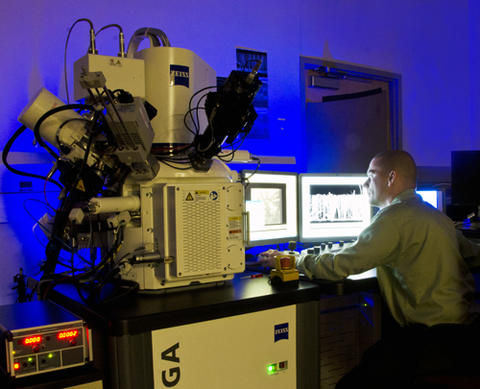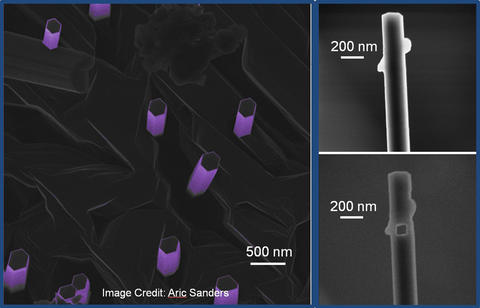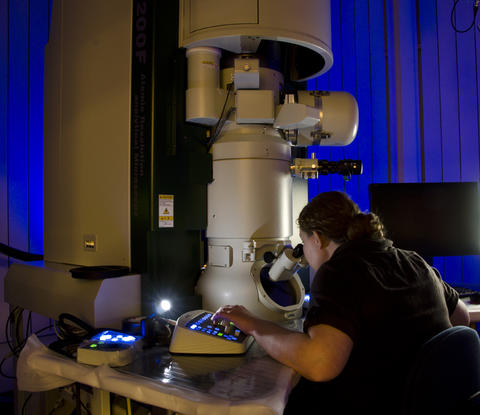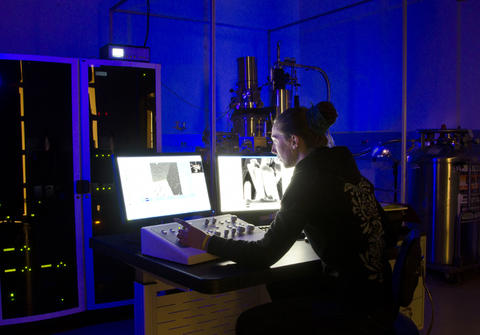
PIF's Aric Sanders demonstrates imaging options on the FIB/SEM instrument.
NIST is taking a huge step into the ultra-small with the Precision Imaging Facility (PIF) now being outfitted in new Precision Measurement Laboratory on the Boulder campus. The PIF, which houses some of the most advanced imaging instruments in the world, will give researchers the ability to dissect, create, and catalog technologically important materials and devices at the atomic level, and will fill researchers' microscopy and microanalysis needs for years to come. Completion is scheduled for mid-2012.

The specifications for the 3000-square-foot, shared-use facility were determined by a collaboration of groups at NIST/Boulder, including PML's Time and Frequency, Quantum Electronics and Photonics, and Electromagnetics divisions, as well as the Thermophysical Properties and Materials Reliability divisions of NIST's Material Measurement Laboratory.
The PIF's technological capabilities – the most sophisticated available outside certain Department of Energy facilities – will particularly benefit programs which rely on the complicated interworking of nanoscale materials and microfabrication technology that can only be probed by advanced imaging tools. Eventually, the full suite of instruments will include an aberration-corrected transmission electron microscope (TEM), a combination focused ion beam/scanning electron beam microscope (FIB/SEM), a helium ion microscope, and a local electrode atom probe (LEAP).

- The TEM opens the door to sub-angstrom (1 Å = 10-10 m) resolution imaging necessary for the characterization of crystalline materials used for single photon emitters, nanoscale light sources, and advanced quantum information circuits. The aberration-corrected TEM, the electrons from which pass completely through the specimen and are imaged on the other side, can locally investigate chemical composition, creating the ability to evaluate directly the results of advanced crystal growth techniques needed for the next generation of such devices.
- The FIB/SEM combines two functions that together enable highly precise, three-dimensional manipulation and preparation of samples. A focused beam of ions selectively mills devices and materials at nanometer scales, while the sample is also imaged by an SEM. The combination can reveal internal structure in exquisite detail, and provides an indispensable tool for the preparation of samples for the other analytical techniques such as atom probe and transmission electron microscopy.
- The helium ion microscope provides a completely new methodology for imaging surfaces of biological and inorganic materials. Because of the nature of helium ion-sample interactions , this tool also provides the ability to pattern samples without the limitations of imposed by electron beam techniques thus opening the path to devices of sub-10 nm sizes with sub-15 nm spacing.
- Local-Electrode Atom Probe (LEAP) devices produce the highest spatial resolution currently available for analyzing specimens at the nanoscale. The PIF's LEAP, when installed, will reconstruct analytic volumes atom by atom, revealing the location and chemical composition of structures invisible to other methods. In particular it has a sensitivity to atomic species and location that is unmatched in other analytic instruments. The atom probe is the only microscope that can achieve 1 part per million resolution in chemistry and effectively single atomic spatial resolution. Although averaging techniques can yield higher chemical resolution (1 He atom in 106 Si atoms, for example) they average over a larger area to achieve this. The new LEAP will offer NIST researchers the ability to investigate, for example, the distribution of dopants in nanoscale semiconductor devices.

Operation of the PIF is modeled on the very successful cooperative Boulder microfabrication facility which has been in existence for many years. In this operational model all projects at NIST Boulder have access to the PIF and the extension and refinement of the facility and its resources evolves continually to meet the needs of NIST's world-class research.
Any mention or image of commercial products within NIST web pages is for information only; it does not imply recommendation or endorsement by NIST.

